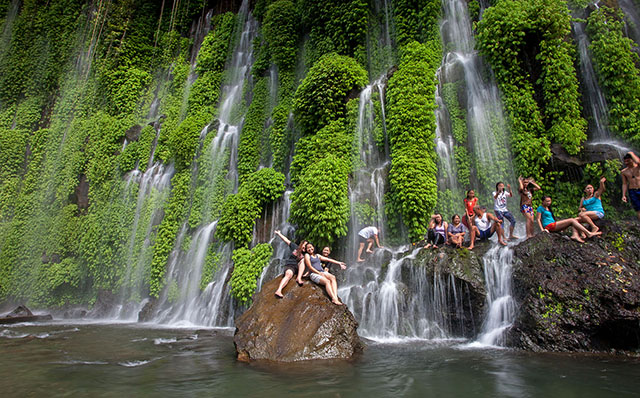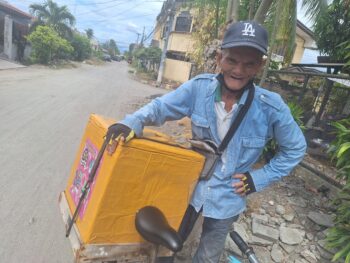ASIK-ASIK FALLS, Alamada, North Cotabato (MindaNews / 29 Dec) — There are not enough adjectives to describe the wonder of Asik-asik Falls, located in Sitio Dulao of Barangay Upper Dado, Alamada, North Cotabato. One can begin using words like fantastic, fabulous, majestic, mesmerizing to words like magical and mystical. But words are never enough to describe a sight one has to see to actually believe exists. Few are the privileged ones who found their way to this enchanted place which one can easily assume was once the local Indigenous People’s sacred space.
If one were to stumble here all by oneself with hardly another soul present, it would be easy to assume that this was a spot where water nymphs frolicked. In the silence and serenity of its surroundings – disturbed only by the sound of waters gushing out from cliffs and falling on stones below and the chirping of birds – perhaps one could hear them sing. But these days, hordes of tourists have begun descending on this faraway place and with the noises they make, perhaps the nymphs have abandoned their abode and relocated elsewhere.

Fortunately for now, those who visit Asik-asik are still relatively small and have not reached a number that would overwhelm the limited space of this site. Part of the reason why huge groups of tourists have not inundated this place is its inaccessibility.
Nestled in the lower slope of Mount Ragang (also known as Mount Piapayungan and now referred to as the Blue Mountain, an active strato-volcano that sits on the boundary of North Cotabato and Lanao del Sur), it can only be reached after long hours of driving from the cities of Cagayan de Oro, Malaybalay, Cotabato, General Santos and Davao. If one has no vehicle that can reach Sitio Dulao, the spot where one begins the long trek down to the falls, the only option from Alamada poblacion is via the habal-habal.
Fortunately, owing to its tourism potential, a road has been cemented between Alamada and Sitio Dulao where there was once only a dirt road and wooden rickety bridges. The local government has also begun providing cement and steel stairways to go down to the falls from the staging area where vehicles could be parked down to where the river flows. But there are parts of the pathway without stairways and one imagines that during the rainy season these would be muddy and slippery. The trek going down and then up means taking more than a thousand steps. Depending on how fast one walks, going down could take from 15 to 25 minutes and coming up from 30 to 40 minutes.
Of course, the hike can be daunting for those who do not follow a regular exercise schedule. But even if this walk can be a bit tiring, one can so easily forget the inconvenience for the sight that awaits below can take the breath away. At the base of the steep hills when the hike ends upon approaching the river, one still needs to walk a few meters before the beautiful sight is revealed. A bridge then crosses the river and there for the first time, the sojourner has a view of the majestic falls. One sees something much than one expected as one is instantly mesmerized.
One is faced with cliffs that constitute a towering wall approximately measuring 140-meters wide. From the base where the river flows, one looks up to the top of the cliffs and imagine a 25-storey high rugged skyscraper carpeted with a variety of foliage of palms, ferns, tropical plants and moss. In this lush vegetation, there are small orange flowers that bloom. Mid-way through this stone tower and across its length, crystal waters sprout out of crevices cascading down to a shallow rocky pool below before flowing into a stream which is a tributary of the Alamada River. The cliffs actually are shaped into a curve, following the direction of the river’s flow that bends around the corner.
As the continuous gushing of the waters takes place, so also its sprinkling to various directions. Thus, its name asik-asik, the Hiligaynon term for sprinkle-sprinkle. (One can then assume that the migrants to arrived here to mix with the native Maguindanaons were from Panay Island).
For a few minutes, one just wants to sit down on a rock and gaze at this nature’s beautiful gift to those who have eyes to see. One can so easily say a prayer to thank the heavens for this gift. And keeping the noise at bay, it is then that one imagines that once upon a time, this was, indeed, the water nymph’s hidden garden. Once the meditative mood gives way to the curiosity of the mind, a few questions arise.
How is this kind of waterfalls possible? For sure, there is no river or stream above the towering wall. There is one below that flows through the cliffs then further down. As there seems to have been no geological study informing the tourist where the waters come from, one makes a guess regarding the mystery as to where the water emanates: somewhere upriver, part of a river branched out and followed a path that would lead to an underground cave or tunnel and then end up here as the waters gush out of the crevices and finally rejoin the river. Unless there is a spring up there in the cliffs from where the water comes from.
How come Asik-asik was only recently discovered? Perhaps the Indigenous People who had lived here since time immemorial knew of this place but as the area was thickly forested, they rarely visited the site. Or assuming this to be a sacred place, they only came here for occasional rituals. But as the surrounding areas began to be cultivated – for the hills must have been very fertile after the forests were felled down – the local migrant peasants must have found their way to this site and kept the knowledge to themselves, thinking this was not something extraordinary. Thus for a long time, the beauty of such grandeur was left unnoticed. There were also armed conflicts affecting Alamada during the height of the Moro rebellion. Thus few would feel very safe going around the area. Thus, one story goes that Asik-asik Falls was discovered by the military during a clearing operations. Eventually, the local government officials learned of this site at the time when local tourism began to be popular. And with the improvement of peace and order conditions in North Cotabato, tourists could be enticed to visit the site.
So roads and bridges to the site were constructed. At the staging area where tourists begin the hike, buildings were constructed and the space was fenced so those who want to stay overnight feel safe. Stairways began to be cemented. Where there were no hotels or lodging places available for tourists who travel from far areas, now there are a few possibilities for overnight stay right there in the staging area. There are also restaurants, souvenir shops and stores selling everything from strawberries (which can be locally grown) to carnation and begonia flowering plants. The LGU (local government unit) collects 30 pesos as entrance fee per person and 25 pesos for parking fee.
Having visited some of the fabulous waterfalls across Mindanao, Asik-asik has its own unique features. Unlike those of Maria Cristina in Iligan, Tinago in Lanao Norte, Tinuy-an in Bislig, Aliwagwag in Cateel and those of Lake Sebu, Camiguin and Samal Island, it is only Asik-asik that has this unique feature of many waterfalls cascading from towering cliffs. But unlike Tinuy-an and Tinago, there is no deep lake beneath the waters. The river is shallow and rocky. Its standing space is very limited. A hundred people coming together and sharing its space would already constitute a big crowd.
The LGU overseeing this site was wise in passing a resolution to leave the trees, bushes and plants intact and not to build kiosks or any fixed structure in the site (except the bridge), thus preserving its rugged look. For the moment, the place is still clean as there are notices reminding the tourists to “leave no trash, leave no trace.” However, as we ended our visit, we were told that there is a plan to build a zip-line to bring tourists from the staging area down to the edge of the waterfalls. This way, those who find the trek going down and up to be difficult, will be enticed to visit the place.
Perhaps this is not a wise decision to make for a site like Asik-asik. Not only will the numbers of tourists exponentially increase to a point where its expansion would hurt the beauty and integrity of Asik-asik (remember Boracay, Baguio and other places that have suffered the overcrowding given their limited carrying capacities?) but the experience would totally be different and not so satisfying. For the thrill of Asik-asik is precisely this: one has to be willing to sacrifice but in the end will be rewarded with a gift of immense beauty! [Redemptorist Brother Karl Gaspar is a professor at St. Alphonsus Theological and Mission Institute (SATMI) in Davao City and a professor of Anthropology at the Ateneo de Davao University. Gaspar is author of several books, including “Desperately Seeking God’s Saving Action: Yolanda Survivors’ Hope Beyond Heartbreaking Lamentations,” two books on Davao history, and “Ordinary Lives, Lived Extraordinarily – Mindanawon Profiles” launched in February 2019. He writes two columns for MindaNews, one in English (A Sojourner’s Views) and the other in Binisaya (Panaw-Lantaw).]







